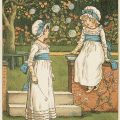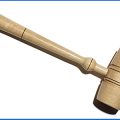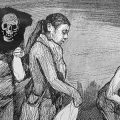2019 Artists at Work
The 2019 Artists at Work exhibition is on display in the Ripley Center through Summer 2020.
This juried exhibition, the Smithsonian Community Committee’s seventh staff art show, highlights the often unexpected talents within the Smithsonian community. Fifty-two works were chosen from among 169 entries to the 2019 Artists at Work competition. The subjects of these works and the materials from which they are made are as diverse as the people who comprise the Smithsonian family and the collections of the Institution itself.
“Throughout my time at the Smithsonian, art has always been a respite for me,” said Secretary Lonnie Bunch at the exhibition’s opening in October. “One of my escapes has been to wander through our galleries and enjoy the artistic creativity all around.
“Today’s exhibition reminds me that this creativity isn’t limited to our walls; every day, regardless of division or department, we’re buoyed by the deep currents of talent, imagination, and artistry that flow throughout this Institution,” he continued.
Artists at Work showcases images and forms inspired by the lure of distant lands and the love of the familiar. These creations of paint, canvas, paper, wood, fabric, metal, stone, and clay speak of the artists’ fascination with the world around them—objects, ideas, and people often encountered through their work with the Smithsonian. They are evidence of the inspired, after-hours activities of our staff, research fellows, interns, contractors, and volunteers. Their reserves of energy, imagination, and skillfulness enhance all aspects of our everyday work.
Khalid Alsarraj
Management and Program Analyst
Office of Sponsored Projects
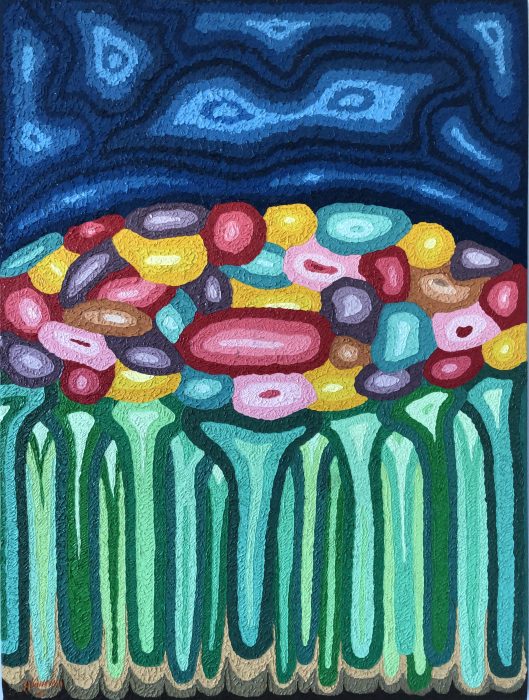
“Spring” 2005
Khalid Alsarraj
Oil on canvas
Khalid Alsarraj (Born in Baghdad,Iraq in 1969.) Other artworks can be found in www.khalidalsarraj.com
Juliana Bedoya
Visitor Services Associate
Hirshhorn Museum and Sculpture Garden

“Bottleneck” April 2019
Juliana Bedoya
Mixed Media
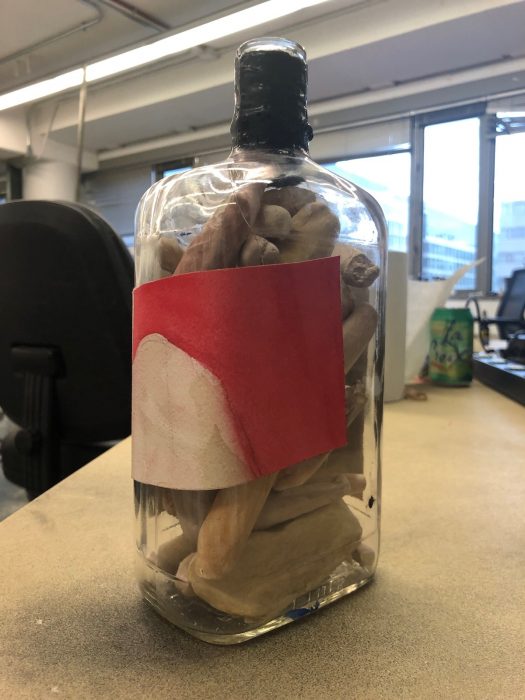
(Detail) “Bottleneck” April 2019
Juliana Bedoya
Mixed Media
Having worked at the Hirshhorn for the past 2 years, I have been surrounded with artwork that speaks often to a sociopolitical issue that the artist finds to be pressing in their community. This has inspired me to be equally as proactive in my own work, making me confront personal yet social issues through my artwork.
Brittany Brown
Preschool Educator
Smithsonian Early Enrichment Center

“Black Diamond” April 28, 2019
Brittany Brown
Digital

“Black Diamond” April 28, 2019
Brittany Brown
Digital
Smithsonian continues to remind me to embrace & explore my culturally creative background, while simultaneously inspires me to create Art/ Platforms of diversity and inclusion.
Nico Carver
Librarian for Collaborative Programs
Smithsonian Astrophysical Observatory

“Hidden in the Wings – Astrophotography of Nebulae in Cygnus” Nov. 26, 2018
Nico Carver
Photography inalterably changed the methods used by astronomers to capture and understand the mysteries of our universe. I find it rewarding to support current and historical work done by astronomers at the Smithsonian Astrophysical Observatory in a scientific setting, and to participate in astronomical imaging as an artistic endeavor myself through my amateur astrophotography as seen here.
Marcy Chevali
Intermittent Exhibition Worker
Cooper Hewitt, Smithsonian Design Museum
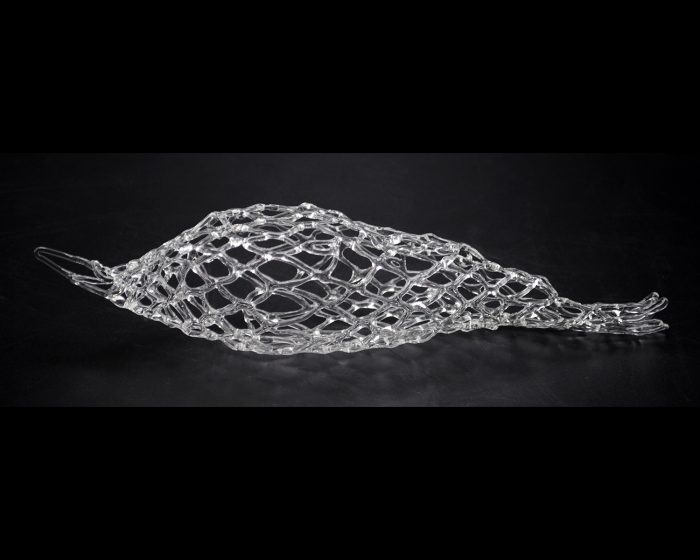
“Vee” 2018
Marcy Chevali
Flameworked glass
Keith Conway
Exhibits Specialist (Mountmaker)
National Museum of African Art
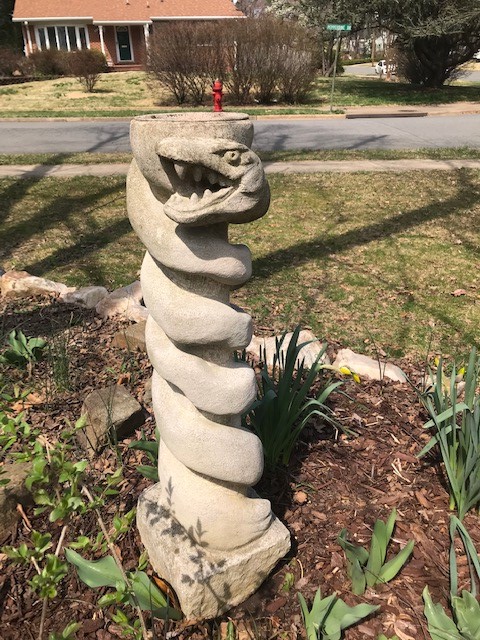
Bird bath with reptile hybrids, 2010, reworked 2019
Keith Conway
Solid limestone
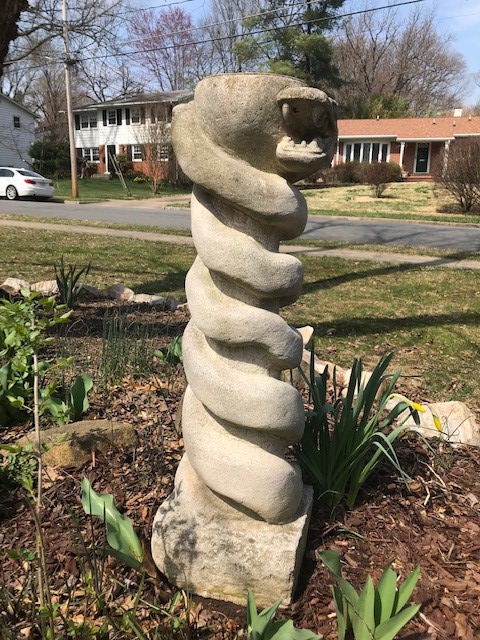
Bird bath with reptile hybrids, 2010, reworked 2019
Keith Conway
Solid limestone
This hand chiseled stone bird bath is a statement about nature, surrounding nature, created from natural stone.
Aaron Crabtree
Construction Manager
Office of Planning, Development and Construction

“Icelandic Horses” November 2018
Aaron Crabtree
35 mm photography
Tuomas Easton
TI, SAAM AV and Exhibitions
Smithsonian American Art Museum

“CUBRIS” January 2019
Tuomas Easton
Paper craft and LED
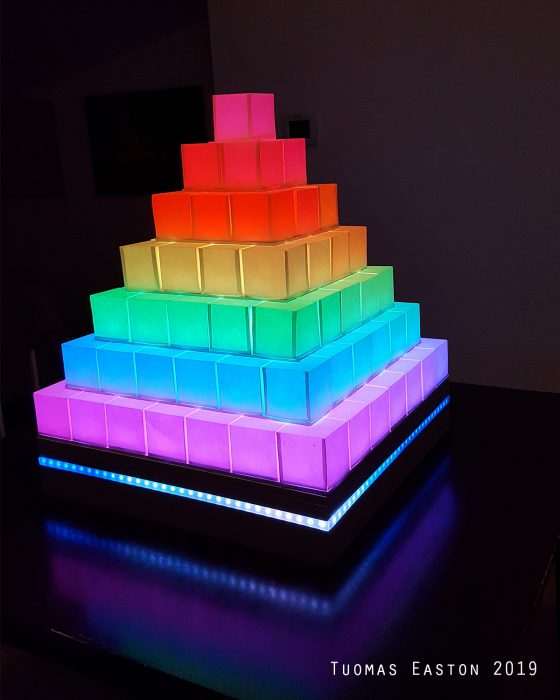
“CUBRIS” January 2019
Tuomas Easton
Paper craft and LED

“CUBRIS” January 2019
Tuomas Easton
Paper craft and LED
Bonnie Fitzgerald
Instructor, Contemporary Mosaics
Smithsonian Associates

“My Mom” 2019
Bonnie Fitzgerald
Mosaic, Picassette
Inspired by my Smithsonian students while teaching “The Art of the Broken Dish”, I created this picassette style mosaic with cast-off dishes and crockery. The mosaic includes Mom’s dishes, and lots of other “mother’s” dishes collected from thrift stores and yard sales. This is my first picassette portrait.
Joel Floyd
Volunteer
National Museum of Natural History
Department of Entomology
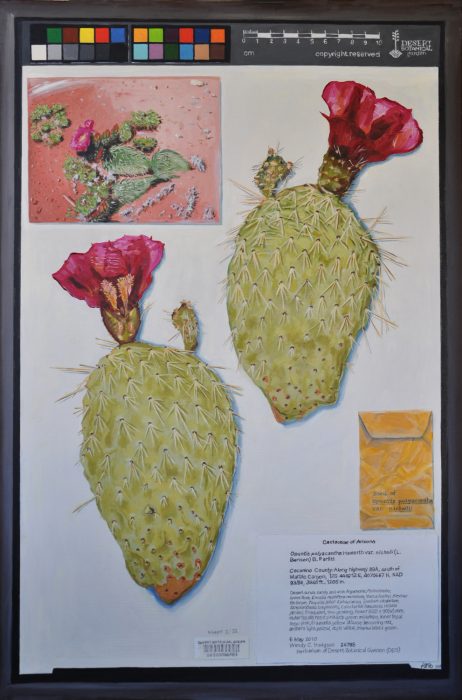
“Plains Prickly Pear Cactus Herbarium Specimen” 2015
Joel Floyd
Oil and ink on canvas
I am a free-lance scientific illustrator but also am interested in the trompe l’oeil (“fool the eye”) painting tradition. I like how herbarium specimens found in museums include not only the flatted plant specimen and collection information, but also other artifacts such as photographs to document the live plant and envelopes of seeds of that species. In this painting I used a scan of Opuntia polyacantha, the Plains prickly pear cactus split in two and posted on-line by the Desert Botanical Garden in Phoenix, Arizona. I used the image with permission as a reference to draw interest to the subject by depicting it more than twice the actual size and include the color chart and scale used to photograph the original specimen.
Josh T. Franco
National Collector
Archives of American Art
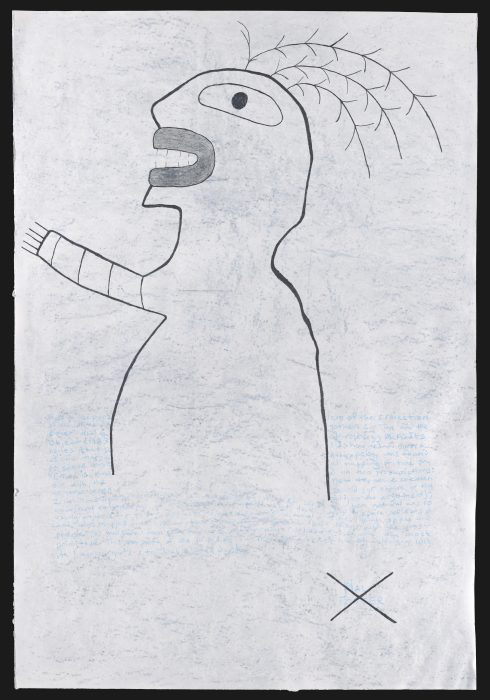
The Primitives’ Revenge (Hal Foster, “The Artist as Ethnographer,” 1995) 2018
Josh T. Franco
Watercolor pastel and colored pencil on paper
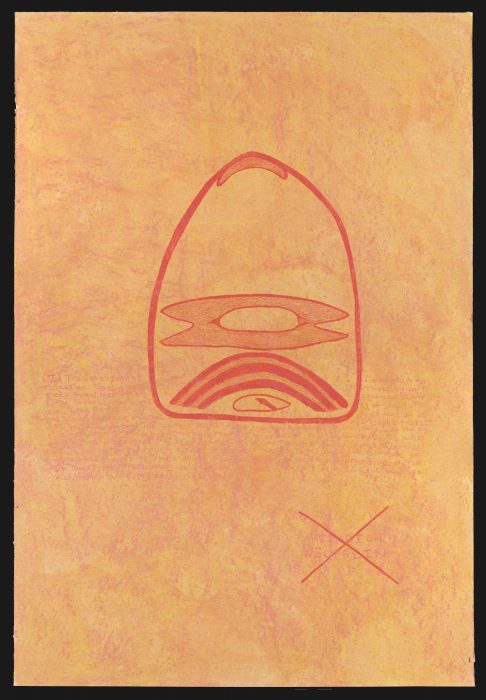
The Primitives’ Revenge (Hal Foster, “The Artist as Ethnographer,” 1995) 2018
Josh T. Franco
Watercolor pastel and colored pencil on paper
‘The Primitives’ Revenge’ series of works on paper pairs reproductions of ancient pictographs from Hueco Tanks in West Texas with hand-transcribed passages from art historical texts where the term “primitive” appears. As National Collector for the Archives of American Art, I am tasked with uncovering the materials that tell the story of American art. As an artist, I am obsessed with a related, but unanswerable question: What is the story of the first ever human-made mark?
James Gagliardi
Supervisory Horticulturist
Smithsonian Gardens
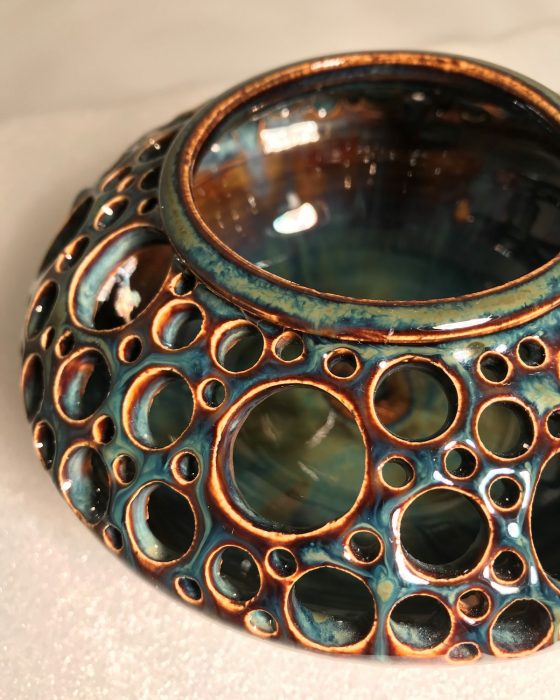
“Holey Vase” January 2019
James Gagliardo
Ceramic
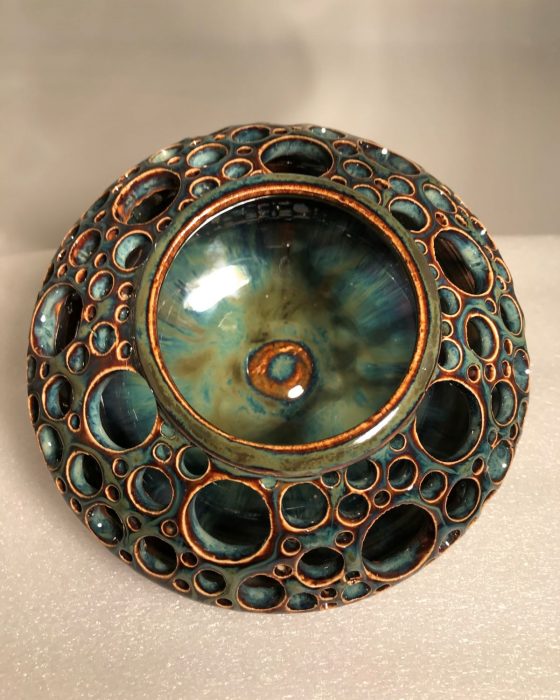
“Holey Vase” January 2019
James Gagliardo

“Holey Vase” January 2019
James Gagliardo
hosted annually by the Women’s Committee
As a horticulturist with Smithsonian I have always enjoyed ability to get my hands dirty and create something beautiful. As my career advance to a supervisory role I was glad to find a local DC Parks and Recreation center with a pottery studio that provided me with a new venue for my artistic expression. The inspiration for this piece came from a visit to the Smithsonian Craft Show hosted annually by the Women’s Committee.
Paul Glenshaw
Studio Arts Instructor, Smithsonian Associates
Contributor, Air & Space magazine

“Scoliosis specimens, National Museum of Health and Medicine” 2018 – 2019
Paul Glenshaw
Carbon pencil
Nancy Hacskaylo
Senior Graphic Designer
Freer and Sackler Galleries

“I Caught You” March 2019
Nancy Hacskaylo
Encaustic gesso with powdered pigment, india ink on top of encaustic medium mounted on dibond
Katherine Harris
Intern
Smithsonian Environmental Research Center
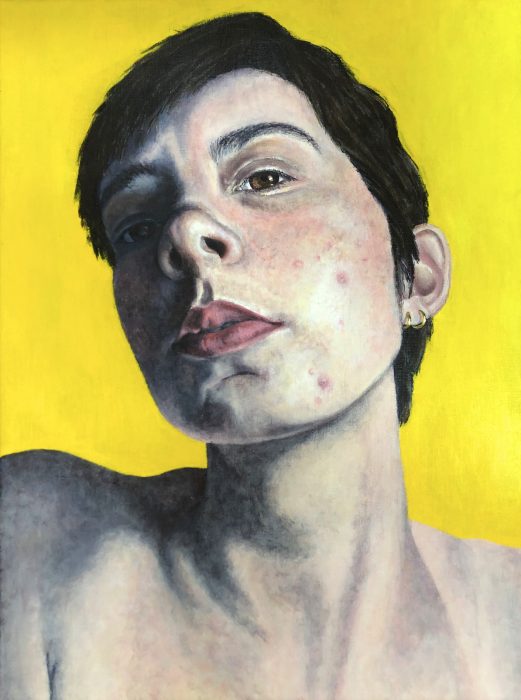
“Self-portrait” April 2019
Katherine Harris
Acrylic on canvas
Michelle Lisa Herman
Digital Experience Manager
Archives of American Art

Title of Work Untitled (The Treachery of Images) 2018
Michelle Lisa Herman
Acrylic on canvas
My current body of work is centered around the limits of perception. In both of my roles— a technologist and an artist—art and technology frequently merge. Sometimes it can be difficult to distinguish which has influenced which. However, this piece was directly inspired by the work of my SI colleagues working with machine learning and artificial intelligence as well as seeing Magritte’s famous The Treachery of Images painting in a different light. This painting represents the first in a series of investigations into the limitations of perception.
Michael Holt
Assistant Manager, Smithsonian Enterprises
National Museum of American History

“75th Anniversary Special”
Michael Holt
Cut magazine and X-Acto knife
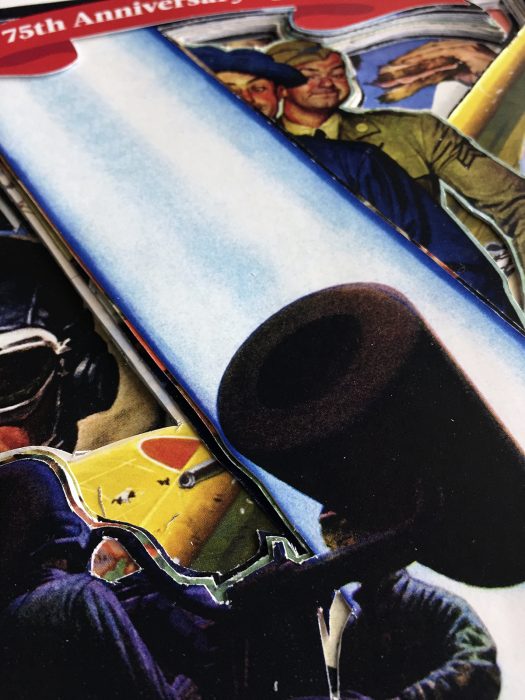
(Detail) “75th Anniversary Special”
Michael Holt
Cut magazine and X-Acto knife
My work is created by cutting directly into magazines with an X-Acto knife to reveal the contents. I do not add material, I only remove and allow it to remain the object. It serves as a record of the subconscious of the material, and my explorations within it. They are typically displayed on a pedestal for showing.This particular magazine was purchased in our gift shop at NMAH.
Laura Horelick
Objects Conservator
National Air and Space Museum, Udvar-Hazy Center
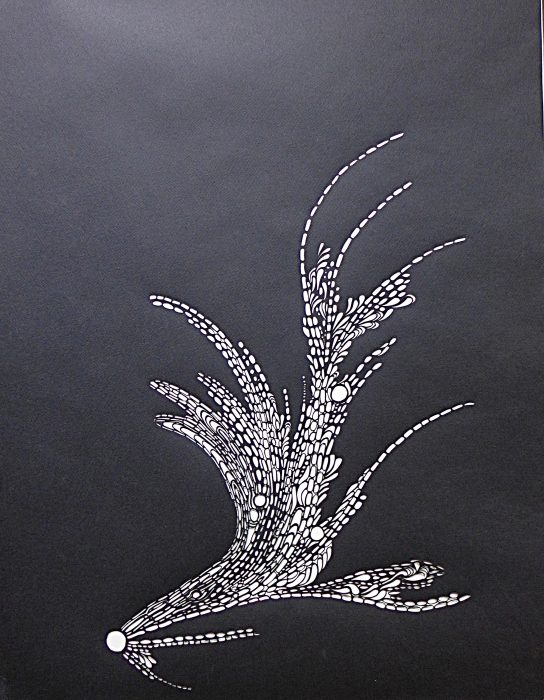
“Escape Routes: Underground Railroad” 2018
Laura Horelick
Hand-cut paper
Ashley Hornish
Exhibit Designer
National Air and Space Museum
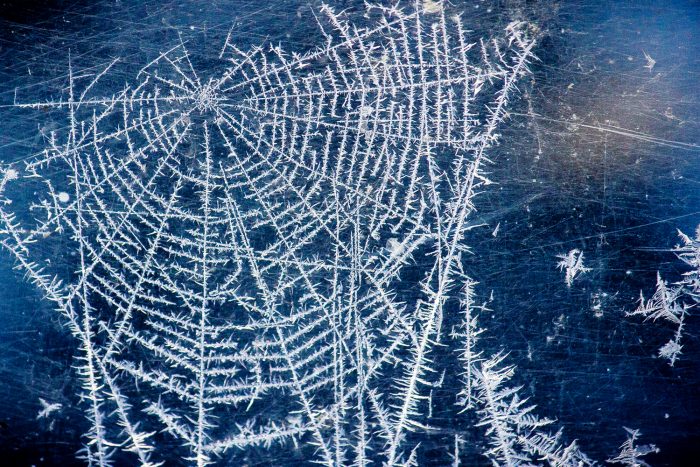
“Frosty Spiderweb” January 2018
Ashley Hornish
Photography
Marcie Wolf Hubbard
Studio Arts Instructor
Smithsonian Associates
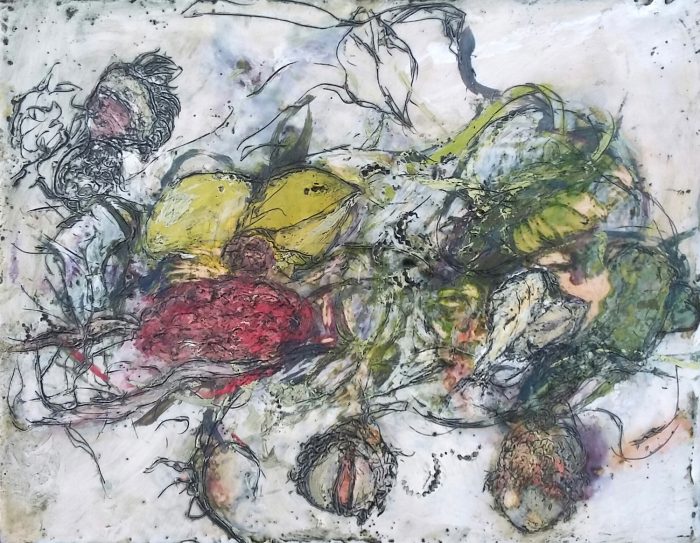
“Barbed Organics” 2018
Marcie Wolf Hubbard
Encaustic, oil stick on paper
Lauren Kingsland
Studio Arts Instructor
Smithsonian Associates

“Love Notes with Kolam” 2011
Lauren Kingsland
Quilt
Joy fills me as I teach quiltmaking for the Studio Arts program where students from all over the world come together to be creative. Quilting is about connection, putting the pieces together and making something beautiful from what is at hand. “Love Notes with Kolams” is improvisation, passion, cross-cultural influences (through the South Indian Kolam designs) and styles of communication.
Martin J. Kotler
Frame Conservator
Donald W. Reynolds Center

Waterfront View from Anacostia Park11th St Bridge 2018
Martin J. Kotler
Oil on linen
Catherine Liang
Volunteer
National Museum of Natural History

“Bursting at the Hinges” Dec. 15, 2018
Catherine Liang
Casein Paint
Through engaging with visitors as a volunteer, and being part of the Smithsonian Community, I’ve discovered the vast amount of wonder in every corner of the world. My work seeks to express not only the abundance of resources in our institution, but also the incredible diversity of people and experiences.
Savannah Loebig
Program Assistant
Office of Visitor Services

Excerpt from ‘Deconstruction of the Female Body’ 2017
Savannah Loebig
Oil on canvas
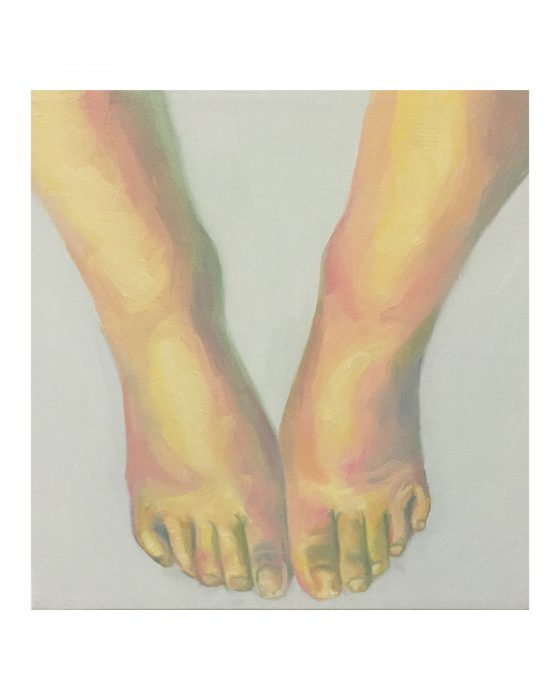
(Detail) Excerpt from ‘Deconstruction of the Female Body’ 2017
Savannah Loebig
Oil on canvas

(Detail) Excerpt from ‘Deconstruction of the Female Body’ 2017
Savannah Loebig
Oil on canvas
Sushmita Mazumdar
Studio Arts Instructor
Smithsonian Associates

Safarnama: Story of a journey, Sept., 2018
Sushmita Mazumdar
Acrylics, ink, paper on canvas
As I started to teach calligraphy recently, it was exciting to go back and explore my native Devnagari script (used for Indian languages like Sanskrit, Hindi, and Marathi). I learned calligraphy in art school 30 years ago in India and in this artwork, Safarnama: Story of a Journey, a favorite recent Bollywood song with a Urdu name turns into an image, and a color from a dream tells the story of a journey.
Laura E. McClure
Visual Information Specialist
National Museum of American History

“Osprey” March 9, 2019
Laura E. McClure
Watercolor on cold press paper
Caleb Menzies
Exhibit Specialist
Smithsonian Institution Exhibits

Untitled 2018
Caleb Menzies
Ink on paper
Diana Liz Miles
Volunteer
National Museum of Natural History

“Los Elementos” 2015 Diana Liz Miles
Intaglio metal
I work at the butterfly pavilion which is very large. I am a lover and fierce defender of nature, and animals and especially insects are my main source of inspiration. Being able to closely study them, their colors and patterns is a great gift. All our vitrines full of so much human and animal science, all the kids and their parents who visit us daily are truly incredible. How could I not have a mind full of artistic creativity.
Tea Okropiridze
Instructor, Tapestry
Smithsonian Associates
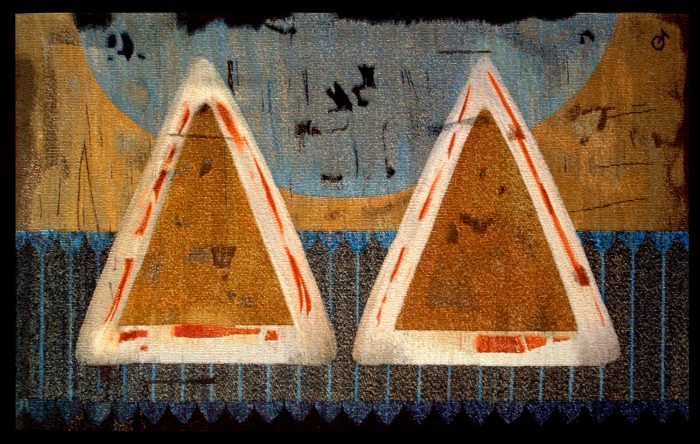
“Connection” 2004
Tea Okropiridze
Tapestry: wool and nylon on cotton warp
Ari Post
Curatorial Contractor: American Art
Freer and Sackler Galleries

“Babe” December 2018
Ari Post
Linocut
It’s humbling to walk through the galleries of the Freer and Sackler on the way to my desk each day, to be confronted in life’s mundane and interstitial moments by the most beautiful handmade objects in history. That has a way of trickling into your unconscious. The Smithsonian museums have always served as a source of enduring guidance for my art practice, but working here over the years has enhanced my relationship with art in such subtle and immeasurable ways. Our collections and galleries are a wellspring of education and inspiration for any artist, and I’m grateful to be so deeply connected to them.
Daniel Riesmeyer
Studio Arts Instructor
Smithsonian Associates
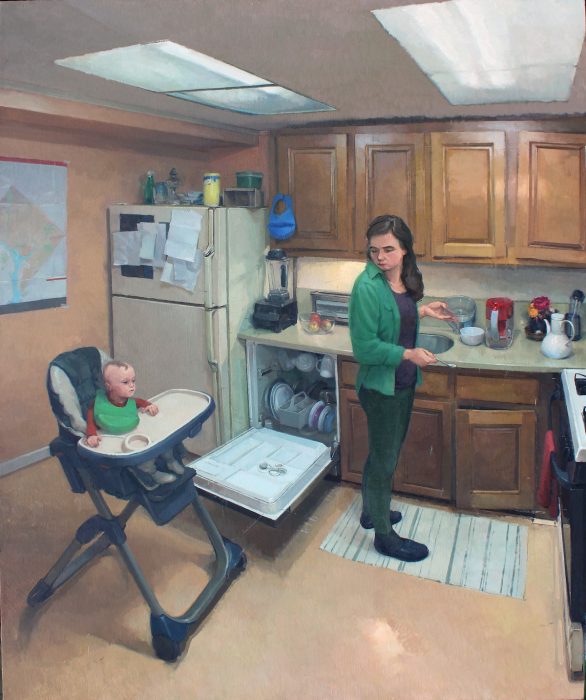
The Meal, 2019
Daniel Riesmeyer
Oil on linen
Kim Sandara
Gallery Attendant
Smithsonian American Art Museum
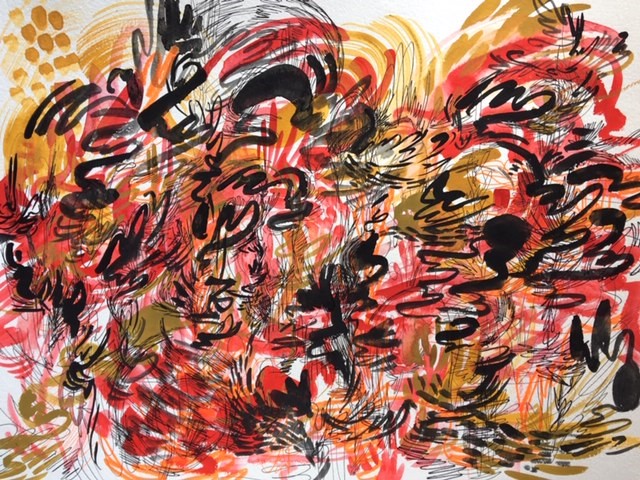
“Get it Together” 2019
Kim Sandara
Gouache, pen, marker on paper
My work is a translation of sounds to visuals, created in an action-oriented, stream-of-consciousness manner. Over time, the paintings have become less about music interpretation and more about reaching halfway to the audience’s personal interpretation. Immediate reactions are as valid as an artist’s intent.
Miguel Santiago
Visitor Services Associate
Cooper Hewitt, Smithsonian Design Museum

“Broken Window Screen” 2010
Miguel Santiago
Photograph
Lori VanKirk Shue
Studio Arts Instructor
Smithsonian Associates

Basket Weaving: Natural Dyed Reed, Willow, Palm, Bittersweet Vine, Leather, Deer Hide Fur, Horse Hair, Spun Wool, Sinew, Hawk Feather, Crab Claw, Precious Stones 2019
Lori VanKirk Schue

Basket Weaving: Natural Dyed Reed, Willow, Palm, Bittersweet Vine, Leather, Deer Hide Fur, Horse Hair, Spun Wool, Sinew, Hawk Feather, Crab Claw, Precious Stones 2019
Lori VanKirk Schue
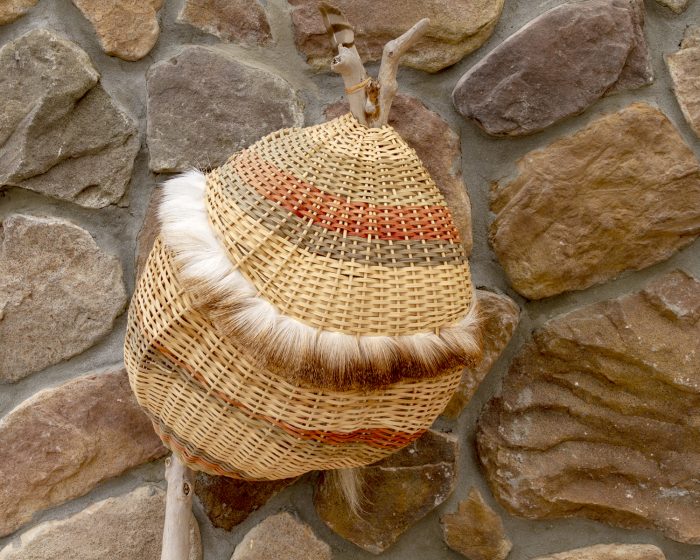
Basket Weaving: Natural Dyed Reed, Willow, Palm, Bittersweet Vine, Leather, Deer Hide Fur, Horse Hair, Spun Wool, Sinew, Hawk Feather, Crab Claw, Precious Stones 2019
Lori VanKirk Schue
When introducing my students to many mediums from basketry to metal point, I ask them not only to think about how the medium behaves but how it makes them feel as they get to know themselves through art. This basket represents a journey. Not only because of its use as a hiking and gathering staff but as a zen art, with the weaving taking me on a journey through thoughts and feelings.
John Shull (Austin Shull)
Lighting Designer
Hirshhorn Museum and Sculpture Garden

“A Field Guide to Materiality: Arches, The Artists Choice Since 1492” 2008
John Shull (Austin Shull)
Inkless Debossing on Arches Cover

(Detail) “A Field Guide to Materiality: Arches, The Artists Choice Since 1492” 2008
John Shull (Austin Shull)
Inkless Debossing on Arches Cover
A piece of Arches paper that has a flowchart embossed without ink into the paper illustrating the extended connections between the piece of paper and the multitude of corporations involved in its production.
Brad Simpson
Digital Imaging Specialist (Photographer)
National Museum of African Art

Untitled 2019
Brad Simpson
Photograph
Kenya Smith
Web Developer
National Museum of Natural History
Department of Entomology

“Silence” 2009
Kenya Smith
Oil on canvas
Jeremy Starn
Intern
Smithsonian Tropical Research Institute
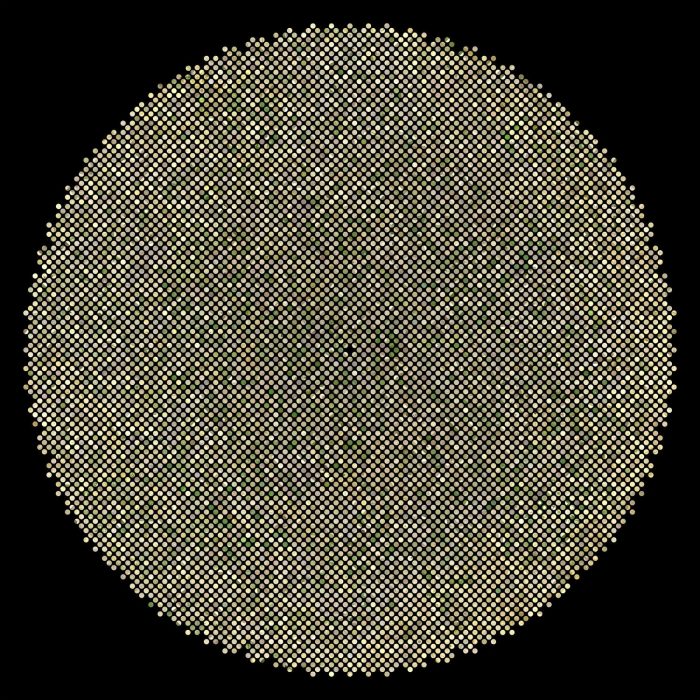
“7,586 Pivotal Irrigation Farms For Each Patent Monsanto Owns” April 2018
Jeremy Starn
False-Color Satellite Collage. Archival Pigment Print mounted on aluminum with metal floater frame
The artwork is a digital collage of false color satellite images of pivotal irrigation farms, collected from the USGS. The collage is then printed on photo paper, mounted to aluminum and framed in a metal floater frame.
Joan Stogis
Volunteer (Event Representative)
Smithsonian Associates
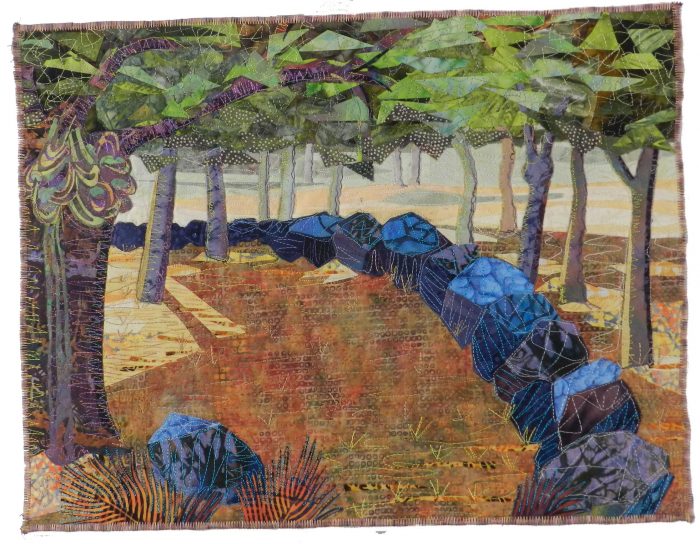
“The Blue Stone Wall” 2013
Joan Stogis
Cotton, fused appliqué, machine quilting
While cruising the Turquoise Coast of Turkey, I went for a dawn walk, and came upon an ancient olive grove and stone wall. In the early light, the wall was almost as blue as I have shown it. My work as a volunteer Event Rep with the Smithsonian Associates has enhanced my appreciation of the beauty of this world, and allows me to support all who participate in our stimulating programs.
Michael Sypulski
Exhibition Worker
Cooper Hewitt, National Design Museum

Untitled 2018
Michael Sypulski
Acrylic on canvas
G. Jackson Tanner
Supervisory Museum Specialist
National Museum of African American History and Culture

“Galazios ourranos” April 2018
G. Jackson Tanner
Golden Fluid Acrylic
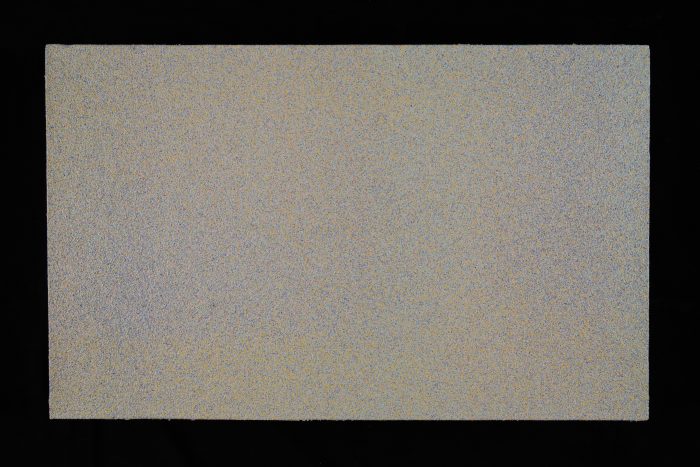
(Detail) “Galazios ourranos” April 2018
G. Jackson Tanner
Golden Fluid Acrylic
Robert Taylor
Volunteer Gallery Guide
Hirshhorn Museum and Sculpture Garden

“Josef Albers” December 18, 2018
Robert Taylor
Photography
Volunteering at the Hirshhorn keeps me grounded and engaged. It offers a way to explore and share abstract concepts through tangible, personal, inclusive experiences. The bridge between conceptual and tangible is a focus of my work (including this composition, which explores an interaction of color through material).
George Tkabladze
Instructor, Sculpture and Drawing
Smithsonian Associates
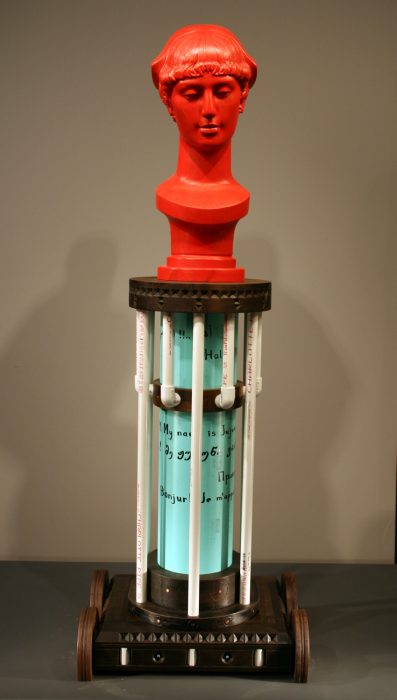
“Hello, My Name is Jujuma” 2010
George Tkabladze
Mixed media

(Detail) “Hello, My Name is Jujuma” 2010
George Tkabladze
Mixed media

(Detail) “Hello, My Name is Jujuma” 2010
George Tkabladze
Mixed media
Alfonso Vicenzio
Intern/Gallery Guide
Hirshhorn Museum and Sculpture Garden
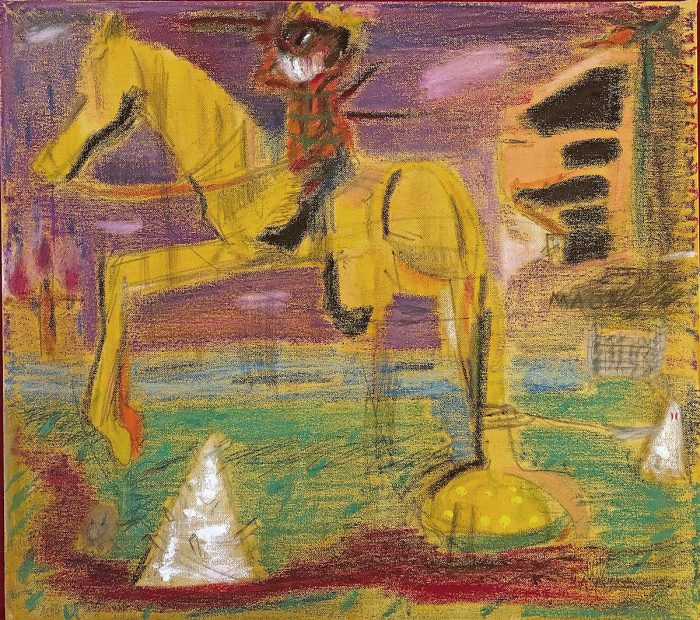
“Yellow Horse (Meleager’s Death)” March 20, 2019
Alfonso Vicenzio
Acrylic, oil, oil pastel, graphite
Joshua Voda
Public Affairs Officer
National Museum of the American Indian George Gustav Heye Center

The Countryside, April 9, 2019
Joshua Voda
Photography
Deborah Merrick Wilson
Studio Arts Instructor
Smithsonian Associates

Emblems of Elizabeth I, 2018
Deborah Merrick Wilson
Precious metal embroidery
Max Karl Winkler
Studio Arts Instructor
Smithsonian Associates

“Woman 2” 2013
Max Karl Winkler
Woodcut
Max-Karl Winkler has taught drawing, figure drawing, and relief printmaking in TSA Studio Arts programs for more than 30 years.
Libby Weiler
IT Specialist
Smithsonian American Art Museum

“The Canyon” 2018
Libby Weiler
Graphite
Drawing for me is a therapeutic activity. I find myself spending hours getting lost in the details of my drawings. A mark, a shadow, a texture are just a few details of the natural world, and I believe it’s in the details of life that art emerges.
Adrienne Kralic Wyman
Studio Arts Instructor
Smithsonian Associates

“A Working Mom, West Africa” 2015
Adrienne Kralick Wyman
Oil on canvas
My job as a studio arts instructor at the Smithsonian Associates adds to my vision as an artist each day I walk into the building. The international community at the Smithsonian broadens my scope of vision and cultural understanding. The opportunities to exhibitions at the Sackler Freer and African art museum on my lunch break is priceless. I am so grateful every day for the opportunity to see the beauty of the world from cultures past and present right where I work. Each exhibition adds a deeper dimension of aesthetic appreciation and sparks inspiration and new ways to incorporate multicultural elements to my art.
Sherry Winkelman
IT Specialist/Chief Archive Specialist
Smithsonian Astrophysical Observatory

“Arnold Rots Retires” April 2018
Sherry Winkelman
Quilt
Arnold Rots, Archive Astrophysicist for the Chandra Data Archive, retired in 2018 after 20+ years of service at SAO. This quilt celebrates some of his many contributions to astronomy. The galaxies depicted (the Whirlpool Galaxy, the Antennae Galaxies, and M81) are a few of the objects he studied in radio and x-ray; three of the observatories he worked at (Chandra X-ray Observatory, Greenbank Observatory, and the Very Large Array) are ‘hidden’ in the quilting; and the clock hands represent his interest in astronomical timing and coordinate systems. At 58, Arnold started running triathlons with his eldest daughter. It seems fitting to have him crossing the finish line and heading into the future.
The Smithsonian Community Committee, founded in 1994, exists to generate enthusiasm for and pride in being part of the Institution, to recognize members of the Smithsonian family and recognize their contributions, to increase staff awareness and understanding of the Institution and to promote interaction among staff of the museums, research centers, and offices of the Smithsonian. The SCC is a non-bureaucratic, grass-roots initiative by staff for staff.
Posted: 22 November 2019
- Categories:
